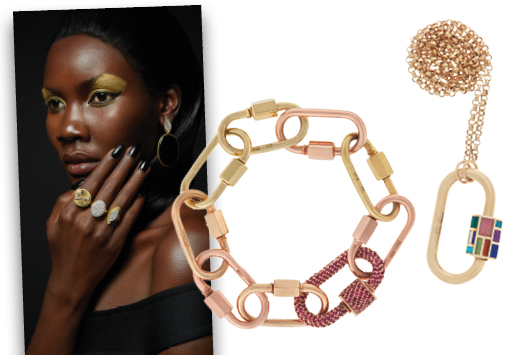
Jewelry designers are finding Instagram to be their secret weapon in promoting sales. Since its launch in 2010, the photo-sharing app — which has more than 800 million users — has become the go-to for fashion followers, and a favorite shopping tool for jewelry lovers in particular.
“It’s not just a visually tantalizing medium, it’s a way to move products,” says Hannah Becker, a graduate gemologist who runs Philadelphia-based jewelry company Diamondoodles. Brands have been facilitating sales on Instagram mainly through direct messaging with customers.
But the app recently added a new shop tab for business accounts in an effort to provide a fuller experience, she notes.
There has been a big shift in the retail pattern, continues Becker, who bills herself as an “artist, nomad and maven.” She acknowledges that millennial consumers appreciate the ability to touch a product like jewelry — something they can’t do online. But they also appreciate the familiarity and direct contact associated with a trusted local jeweler, and that, she says, is something Instagram does offer.
A taste for more
Stephanie Gottlieb, a web-based jeweler and designer who lives in New York, says Instagram has enabled her to create an aspiration lifestyle around her designs, so that her followers want to incorporate her pieces into their own lives. “I have a primarily younger, web-savvy audience that prefers to buy online. My business is largely driven by social media. It allows me to interact with my followers in a very intimate way.”
Gottlieb feels fortunate to have started her business at the same time Instagram exploded in popularity. “It has allowed me to reach a huge audience of people who are really interested in what I’m doing, and it gives those people a direct link to me and the brand. I thought my business would always be ‘word of mouth,’ but Instagram has expanded that to mean something very different. We have clients buying engagement rings through email!”
Connecting with customers
Instagram lets designers share not just product with their audience, but personality as well, says Gottlieb. People approach brands on social media to get to know them, without the sales pitch. Designers see Instagram as a platform for building relationships, getting personal and finding their voice.
“Whether it’s irreverent, earnest or sexy, be who you are,” says Page Sargisson, a designer based in Brooklyn, New York. “It doesn’t work when you try to be something you’re not.”
To bring customers into her world, Sargisson posts time-lapse videos of herself carving pieces at the bench. “I also show that I’m a real person, a designer who knits sweaters and weaves wall hangings, gets caught in the rain and bored at trade shows. I try to keep the majority of it focused on jewelry, but it’s nice to post some personal anecdotes.”
Connecting with consumers can take many forms on Instagram. Los Angeles designer Gia Bahm of Unearthen shares her love of music by posting playlists of songs that inspire her. She also used the app to ring in the New Year with a self-imposed “18 Days of New” design challenge, in which she uploaded videos of herself making a new piece each day. She sold half of what she made during the challenge period, and enjoyed the creative poke.
A loyal following
Gottlieb incorporates fashion and travel into her feed to distinguish it from other jewelry content on Instagram. “It’s important to establish your own aesthetic and keep content consistent to that story. I’ve studied my audience to understand what they like and respond best to, and try to focus my content on making them happy. Your audience will give you feedback often without you even asking — so listen to what they say.”
For New York-based designer Wendy Brandes, the power of this platform hits home when customers who have never met her reach out and ask her to create an engagement ring. “Sometimes they’ve never seen my jewelry in person,” she says, “but they’ve gotten to know me so well through social media and my blog that they trust me to do this emotionally and financially significant design for them. I got an email once from someone who had read my blog for eight years, never commented on it, but now wanted me to do her ring.”
Stoking desire
Instagram is also a platform that builds desire. “Social media games the concept of shopping,” Becker explains. “Consistent posts put your jewelry in front of your followers in a way that a physical store cannot achieve.”
While keeping that up can be time-consuming, she encourages designers to carve out that time or outsource the task to someone they trust to represent their voice. “Don’t feel like you need to post three images a day or even post every day. Make it manageable for you.”
Gottlieb photographs pieces with similar poses and angles to help her users identify her images. “Photos with a lot of layering are more successful than those showing one piece,” she adds, noting that images of jewelry on a body are more successful than product alone.
Brandes concurs, saying it helps to show scale: “You can put the measurements of a piece, [but] customers still will be confused as to how big it is. Wear it yourself if you don’t have the budget for a model.”
Sargisson doesn’t necessarily see immediate sales from her posts, as her pieces are more expensive than an impulse buy. But she says there’s nothing better than when she asks, “How did you find me?” and the answer is “Instagram.”
Image: @wendybrandesjewelry; Marla Aaron jewelry.Article from the Rapaport Magazine - May 2018. To subscribe click here.